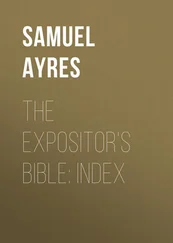Samuel Baird - A Bible History of Baptism
Здесь есть возможность читать онлайн «Samuel Baird - A Bible History of Baptism» — ознакомительный отрывок электронной книги совершенно бесплатно, а после прочтения отрывка купить полную версию. В некоторых случаях можно слушать аудио, скачать через торрент в формате fb2 и присутствует краткое содержание. Жанр: foreign_antique, foreign_prose, на английском языке. Описание произведения, (предисловие) а так же отзывы посетителей доступны на портале библиотеки ЛибКат.
- Название:A Bible History of Baptism
- Автор:
- Жанр:
- Год:неизвестен
- ISBN:нет данных
- Рейтинг книги:5 / 5. Голосов: 1
-
Избранное:Добавить в избранное
- Отзывы:
-
Ваша оценка:
- 100
- 1
- 2
- 3
- 4
- 5
A Bible History of Baptism: краткое содержание, описание и аннотация
Предлагаем к чтению аннотацию, описание, краткое содержание или предисловие (зависит от того, что написал сам автор книги «A Bible History of Baptism»). Если вы не нашли необходимую информацию о книге — напишите в комментариях, мы постараемся отыскать её.
A Bible History of Baptism — читать онлайн ознакомительный отрывок
Ниже представлен текст книги, разбитый по страницам. Система сохранения места последней прочитанной страницы, позволяет с удобством читать онлайн бесплатно книгу «A Bible History of Baptism», без необходимости каждый раз заново искать на чём Вы остановились. Поставьте закладку, и сможете в любой момент перейти на страницу, на которой закончили чтение.
Интервал:
Закладка:
From this ordinance, the form seems to have become a familiar mode of protesting innocence of crime, and is memorable for that occasion when Pilate “took water and washed his hands before the multitude, saying, I am innocent of the blood of this just person: see ye to it.” – Matt. xxvii, 24. Two primitive representations of this scene, in sculptured relief, have been found in the catacombs at Rome. They date from the first centuries of the Christian era. In them the wife of Pilate appears in the background, with averted face. An attendant holds a vase or pitcher in one hand, and in the other a bowl: while Pilate sits rubbing his hands. The position of the bowl shows it to be empty. “The mode of washing implied in the empty bowl is characteristic. In the east, the water is still poured from the vase over the hands, and caught in the bowl, so that it should not pass over them twice.” 16 16 Maitland’s “Church of the Catacombs,” p. 261. Also, Withrow’s “Catacombs,” p. 333.
The manner of washing the feet is illustrated by a fact in the life of our Savior. At dinner, in the house of Simon, the Pharisee, a woman that was a sinner “brought an alabaster box of ointment and stood at his feet, behind him, weeping, and began to wash his feet with tears, and did wipe them with the hairs of her head, and kissed his feet, and anointed them with the ointment.” – Luke vii, 37, 38, 44. But how was it possible for the woman, coming behind him at table, to get access to his feet: which, according to our custom, would be concealed under the table? The ordinary mode of sitting, in the east, then as now, was, on the ground or floor, squat, cross-legged, or reclining. Chairs were not in common use, but were reserved for purposes of state, and used almost exclusively by dignitaries. In later times a bench or settee was introduced, which was without a back. Whether on it or the floor, the usual position, in eating was the same. The guests reclined on the left elbow, leaving the right hand free. The person next on the right thus leaned toward or against the breast of him who was at the head. (John xiii, 23.) The feet were drawn up behind. Persons who wore sandals, always, on entering a house, left them at the door. These were not ordinarily worn by the common people, but only upon occasions of special travel; and our Savior, therefore, forbade his disciples to take time to provide them, in the haste of the mission on which he first sent them to preach. (Matt. x, 10; Luke x, 4.) They poorly protected the feet from the soiling and roughness of the way. 17 17 “Several of them [Arabs of the Jordan] wore sandals, a rude invention to protect the feet. It was a thick piece of hide, confined by a thong passing under the sole at the hollow of the foot, around the heel, and between the great toe and the one which adjoins it.” – Lynch’s “Dead Sea Expedition,” p. 282. These thongs were the “latchets” of Mark i, 7.
Конец ознакомительного фрагмента.
Текст предоставлен ООО «ЛитРес».
Прочитайте эту книгу целиком, купив полную легальную версию на ЛитРес.
Безопасно оплатить книгу можно банковской картой Visa, MasterCard, Maestro, со счета мобильного телефона, с платежного терминала, в салоне МТС или Связной, через PayPal, WebMoney, Яндекс.Деньги, QIWI Кошелек, бонусными картами или другим удобным Вам способом.
1
My authorities are “A voyage to Abyssinia, and travels in the interior of that country, executed under the orders of the British government, in the years 1809 and 1810, etc., by Henry Salt, Esq., F. R. S., etc., London, 1814;” and the personal testimonies of several of our missionaries to the east, who have related to me what they saw.
2
I assume what I believe to be demonstrable, that Paul was the author of the Epistle to the Hebrews.
3
“Carson on Baptism” (published by C. C. P. Crosby: New York, 1832), p. 117.
4
“The Land and the Book.” Vol. II, pp. 531, 534.
5
Below p. 175 Конец ознакомительного фрагмента. Текст предоставлен ООО «ЛитРес». Прочитайте эту книгу целиком, купив полную легальную версию на ЛитРес. Безопасно оплатить книгу можно банковской картой Visa, MasterCard, Maestro, со счета мобильного телефона, с платежного терминала, в салоне МТС или Связной, через PayPal, WebMoney, Яндекс.Деньги, QIWI Кошелек, бонусными картами или другим удобным Вам способом.
.
6
Maimonides, Issure Biah, Perek 13, in Lightfoot, Harmonia Evang. in Joan i, 25.
7
Maimonides, as above, in Lightfoot, on John iii, 23.
8
According to Etheridge, the final revision of the Babylonian Gemara was completed by Rabbi Jose, president of the rabbinic seminary at Pumbaditha, on the Euphrates, in the year 499 or 500. — Jerusalem and Tiberias , pp. 174-176.
9
Tract Pesachim, cap. viii, § 8.
10
This is clearly shown by Etheridge, in “Jerusalem and Tiberias.” Pp. 339 et seq. The same thing is largely illustrated in Blavatsky’s “Isis Revealed.”
11
Compare Ezek. xlvii, 2; John ix, 7. “Go wash in the pool of Siloam, which is by interpretation, Sent.”
12
Carson on Baptism, p. 167.
13
This reading is attested by codices Bezæ, Alexandrinus, Vaticanus, Sinaiticus, and is fully sustained by the internal evidence.
14
Wilkinson, vol. iii, p. 388; Abridged edition, ii, 349.
15
Lynch’s Dead Sea Expedition, p. 206.
16
Maitland’s “Church of the Catacombs,” p. 261. Also, Withrow’s “Catacombs,” p. 333.
17
“Several of them [Arabs of the Jordan] wore sandals, a rude invention to protect the feet. It was a thick piece of hide, confined by a thong passing under the sole at the hollow of the foot, around the heel, and between the great toe and the one which adjoins it.” – Lynch’s “Dead Sea Expedition,” p. 282. These thongs were the “latchets” of Mark i, 7.
Интервал:
Закладка:
Похожие книги на «A Bible History of Baptism»
Представляем Вашему вниманию похожие книги на «A Bible History of Baptism» списком для выбора. Мы отобрали схожую по названию и смыслу литературу в надежде предоставить читателям больше вариантов отыскать новые, интересные, ещё непрочитанные произведения.
Обсуждение, отзывы о книге «A Bible History of Baptism» и просто собственные мнения читателей. Оставьте ваши комментарии, напишите, что Вы думаете о произведении, его смысле или главных героях. Укажите что конкретно понравилось, а что нет, и почему Вы так считаете.












